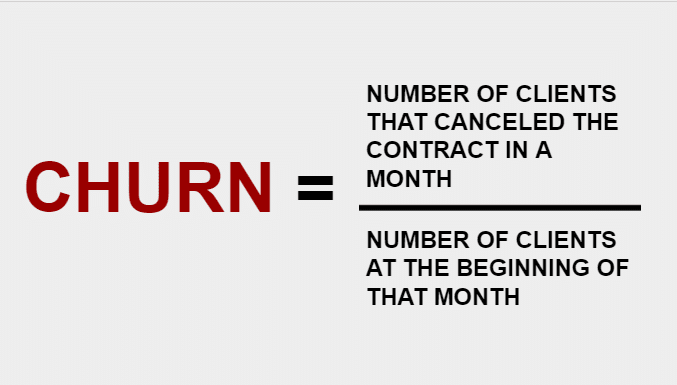In theory, everyone agrees that the likelihood of success for any business is greater when it works on its customer retention.
However, it is common to see companies paying little attention to the analysis of their churn rate.
- Have you been closely monitoring your business’ cancellation rates?
- Do you know what strategies can be used to reduce them?
Understanding the impact of this metric on your company’s financial health will make all the difference to keep it profitable and strong in the market for a long time.
If you still have any questions about this topic, this post will explain what you need to know to keep customer churn under control, including the following topics:
- What is Customer Churn?
- Why Measure Customer Churn?
- What is the Difference Between Churn and Monthly Recurring Revenue Churn?
- How to Calculate the Churn Rate?
- Is There an Ideal Churn Rate?
- Is it Possible to Achieve Negative Churn?
- What Causes Customers to End Their Relationship with a Company?
- How to Reduce your Company’s Customer Churn?
- Wrap Up: Customer Churn is too Important an Indicator to be Left Aside
What is Customer Churn?
The word “churn”, very common in the context of Digital Marketing, was originally used with reference to liquid, and it means “to move or cause to move about vigorously”.
So, in the business world, customer churn is the rate of cancellation, or abandonment, recorded in your customer base.
For some industries, this is a fundamental metric to evaluate a company’s success since it directly impacts revenues. This is the case for subscription services.
Perhaps the best examples in the B2B segment are SaaS (Software as a Service) platforms.
For the end consumer, we can think of telephone and pay-TV companies as examples of the most common services.
Comprehend customer churn and how it is measured brings an important lesson: to monitor this metric properly, the company must have efficient controls for customer management.
In practical terms, the company must use a good CRM and other tools necessary to correctly record and track the customer’s purchase and contact history.
Why Measure Customer Churn?
It is clear that whether or not the customer stays with the company is related to several factors.
Still, every manager should assume that the cancellation was caused by some problem on their own side of the contract.
This idea may seem a bit exaggerated at first but looking at it this way will help you stay alert to all the processes in place to ensure customer satisfaction.
Customers who stay with your service longer offer a greater chance of good business.
After all, the better you know their needs, the more in tune with their demands and expectations your team will be.
This will ensure the effectiveness of the offers you make.
By better understanding the reasons for cancellation, the company becomes more able to make the necessary adjustments in the operation and develop a more efficient action plan to remedy the problems detected.
One thing is certain: analyzing customer churn is essential for those who seek long-term success.
Remember this as you learn more about the causes of churn and tactics to keep it at a safe rate.
What is the Difference Between Churn and Monthly Recurring Revenue Churn?
There is a simple but important difference between churn and monthly recurring revenue churn (also known as MRR Churn).
While the former evaluates the number of customers who canceled your product or service, the monthly recurring revenue churn calculates how much in revenue was lost from these cancellations.
So, if your company has only one plan available to all customers, you don’t need to track monthly recurring revenue churn, as it will be obvious.
But if you have more than one product or plan, it’s worth paying attention to this metric.
For example, imagine that your business offers 3 monthly packages. One costs $50, the second $100, and the third $250.
Losing 5 customers in a month would be bad enough, but knowing they are all from the cheapest plan would reduce the loss.
On the other hand, if the majority were customers from the most expensive package, the problem would be bigger.
Also, tracking revenue churn can help you find and solve specific problems in one type of package without having to worry about the other options.
How to Calculate the Churn Rate?
After understanding the importance of analyzing customer churn, we can get down to the practical part, and learn how to calculate it.
There is no secret to this calculation. Just follow the following formula and multiply the result by 100:

To make it easier to understand, let’s consider an example.
Suppose that in your company there were 100 customers at the beginning of the month. After 30 days, you realize that you have 90 customers.
Following the formula above, with the data from this example, the calculation would look like this:
➤ Churn rate = 10 (customers who canceled)/100 (customers at the beginning of the month) x 100
➤ 10/100 x 100
➤ 0,1 x 100
➤ Churn rate = 10
In this case, your churn rate would be 10%.
How to Calculate the MRR Churn?
We have also talked about MRR churn.
To calculate it, you need to take the average ticket of each customer who canceled. The formula is:
MRR churn = the sum of the monthly amount paid by the customers who canceled
It is also a good practice to measure this number as a percentage to know exactly how much of your monthly revenue has been hurt by cancellations.
The calculation would look like this:
MRR churn in % = sum of the monthly amount of those who canceled/ total revenue for the last month
Keep in mind: this is an important analysis to refine the prospecting efforts, as it helps balance the investments that should be directed to each type of strategy.
In other words, you depend on the churn rate evaluation to develop customer retention, post-sales and even pre-sales strategies.
Is There an Ideal Churn Rate?
In an ideal world, every manager’s dream is to drive customer churn down to zero.
Nobody likes to see clients leaving the company, right?
Besides the direct impact on the revenue, there is the chance that the former customer will spread a negative image of the company, which would weaken the brand and damage its reputation in the market.
But many variables are at play, and it is practically impossible to keep the customer base 100% stable.
So, the general rule is: make sure that your churn rate is always as low as possible.
Since customer cancellation rates can be associated with many factors, it is difficult to determine a fixed value for the rate.
In some sectors, such as SaaS, working with rates around 5% to 7% per year is possible.
Naturally, services that require long-term, high-ticket contracts tend to have lower rates.
Closing the deal (as well as canceling the contract) usually takes time and involves several people, so turnover is low.
Is it Possible to Achieve Negative Churn?
Yes, it is possible. But what is negative churn?
It happens when a business manages to increase sales to the existing customer base, and the revenue exceeds the amount lost to cancellations.
Let’s take the first example, which we cited when talking about MRR churn.
The company lost 5 customers, all subscribers of the $50.00 plan. The total loss is $250.
But in the same month, the company managed to get 3 customers to upgrade from the $100.00 plan to the most expensive one, which costs $250.00.
With these 3 sales to existing customers, the revenue increased by $450.00 — more than the $250.00 lost with cancellations.
This would represent a negative churn.
What is the lesson here? Increasing the average ticket is a great way to reduce MRR churn.
What Causes Customers to End Their Relationship with a Company?
Understanding what goes on in customers’ heads is not always easy, especially when you thought everything was fine and they abandoned your product or service.
It’s no use getting caught up in hunches or completely ignoring the decision.
On the contrary: it is vital that your company at least tries to understand what leads customers to end the relationship.
Only then will you be able to reverse the situation and prevent the same thing from happening to others.
The most common reasons for a client to end the relationship with a company are the following:
1. Delivering less than what was promised
Promising everything and a little more just to close the sale may seem like a good idea when the prospect is indecisive, and the month’s goal has not yet been reached.
But this attitude is very ineffective because the result can be nothing but disappointing.
Sooner or later, the customer will realize that the value delivered does not match what was promised.
If this is the case in your company, change your sales culture immediately.
Customers who give up because of false promises are usually very frustrated and make a point of talking about their bad experiences whenever they have the chance.
2. Lack of attention to detail
Details make all the difference, especially for products with high-ticket prices and used by the so-called enterprise market, composed of large companies.
When a customer spends a lot of money on your solution, they expect everything to be perfect.
Performance problems, lack of agility, and bureaucratic processes are some of the factors that can ruin the customer’s experience very slowly and subtly.
Minor problems pile up and become unforgivable problems at a certain point, and the only remaining action is to look for a different solution in the market.
3. Change in customers’ needs
Just as your company needs to constantly adapt and evolve to remain relevant in the marketplace, your customers change too.
In some cases, they might cancel the contract because their organization needs something that you can no longer offer.
For example, it may be that the type of service you provide is no longer needed.
Another possibility is that the customer just doesn’t have the money to pay you anymore.
The key, in this case, is to realize whether the change in need really makes it impossible to continue buying from you or just requires a different solution from within your own portfolio.
4. End of business
It can always be that the customer in question ultimately terminates the activity that requires the use of your product.
For example, in the case of a company that goes bankrupt, there would be no point in trying to make the person reconsider the decision.
It also shows that it was an external factor, and not a problem of your business, that caused the cancellation.
It is always valid to assume that the problem is on your side of the contract, but it is essential to follow up on each case to be sure of when the responsibility is yours, and when there is nothing to be done.
How to Reduce your Company’s Customer Churn?
No matter what your business’ church rate is, the goal is always to decrease it.
So, there’s nothing better than to see some practical tips to help you with this task.
We have listed no less than 7 actions that can help you do that. If you follow them closely, you will see customer churn drop quickly.
1. Understand why your customers cancel
The first step to effectively reducing churn is to understand the reasons why your clients cancel.
This can be quite a challenge.
The most common causes range from basic issues, such as lack of money to invest, to those directly related to the service provided.
It’s normal to consider several reasons why someone might cancel. So don’t be reluctant to consider that the reason for cancellation may be the customer’s dissatisfaction with your company.
The important thing is that your staff is effective and quick to find out why the customer is looking for another option.
A quick contact soon after the cancellation is the best way to do this.
2. Identify the customers most likely to leave
Another important measure to lower customer churn is identifying the customers who are most likely to leave the company.
If you succeed in this task, the company’s chances of avoiding the problem are much higher, especially if the reasons are under your control, such as service failure.
The recommendation is that you gather as much information as possible about the customer and watch for signs that something may hinder the relationship with the company.
In practice, this requires monitoring direct interactions, such as a sudden increase in support requests.
In addition, it is worth monitoring what they say about your brand on social networks, Net Promoter Score (NPS) and other indicators of satisfaction.
With good pre-sales work, it is possible to detect even before closing the sale if that is a customer who needs more specific services.
3. Structure a Customer Success team
There is no use in just understanding the reasons for cancellation and which clients are the most likely to cancel.
You need a quick way to solve these problems, and this can usually be achieved with a Customer Success team.
The role of a professional in this area is to anticipate problems and ensure that customers always get good results with the product or service they buy.
Does the customer have a subscription to your service but hasn’t used every feature they are entitled to?
It is better to help them proactively than to wait for them to cancel the contract.
4. Add value to the Customer Experience
Of course, in theory, everyone wants to provide the best for their customer.
- But what about that Customer Support team that is not prepared to solve the problems?
- And the Customer Service team that cannot offer a solution that really leaves the customer satisfied?
Besides having professionals dedicated to Customer Success, the same values must be practiced at every level in the company as part of a customer-centric culture.
This way, the focus will always be on the experience provided to the customers, and they will never have a reason to look for another solution.
5. Be sure to listen to those who use the service
The founders and managers of a business know a lot about their market and their product.
However, nothing compares to your company’s most motivated customers.
Relevant operational details often go unnoticed by those who work on the product and cannot see it through the customer’s eyes.
But it is not enough to have tools to capture feedback if the company does not pay proper attention to them.
It is always good to remember that reports are important, but only if you have someone willing to analyze the data.
Process automation only makes sense if the team applies its intelligence towards the service of what really matters — customer satisfaction — instead of performing repetitive tasks.
6. Align expectations
For those who work with recurring services, a sale well done is one that meets the customer’s demands.
Therefore, do not fall into the trap of seeking a high ticket based on false promises.
In the long run, the results are disastrous because the customer will not only cancel the contract but will also be left with a negative image of your company.
Considering how easy it is nowadays to share experiences, the risks are enormous.
It is impossible to avoid churn, but aligning expectations is a good start to guarantee a long-term relationship with most of your customers.
7. Take action on suggestions received
This is one of the main complaints made by customers: companies do not consider their feedback.
Often, just to cut costs, they even ignore feedback about recurring problems.
Even if it is not possible to solve the issue in the short term, make it a priority and carefully analyze what can be done.
Keep in mind that solving problems is not an expense but an investment. This will help to drastically reduce churn and may even increase your profit margin in the future.
Wrap Up: Customer Churn is too Important an Indicator to be Left Aside
After all, the data you can uncover impacts every aspect of the business in the short and long term.
Use the tips seen here and start this analysis right now.
Did you know that Content Marketing can be a powerful ally in reducing churn?
With this in mind, we prepared a quick assessment to guide you in the process of creating and structuring your Content Marketing strategy. Check it out!









